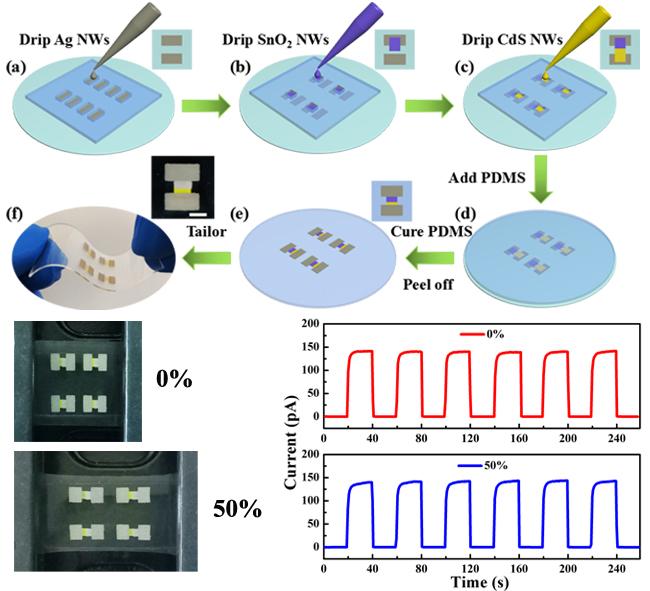
Credit: ©Science China Press
Stretchable electronics, as a kind of “soft” electronic devices which can be stretched, deformed and wrapped onto nonplanar curved surfaces, have attracted tremendous attraction due to their potential applications in wearable electronics, implantable biomedical devices, and artificial electronic skin. So far, many types of stretchable electronic devices have been developed including stretchable transistors, light-emitting diodes (LEDs), supercapacitors, photodetectors and sensors. Ultraviolet (UV) photodetectors have wide applications in crime investigation, biological analysis, fire monitoring, and UV irradiation detection. Stretchable UV photodetectors can be applied in much wider fields owing to their fascinating features of being stretchable, portable, implantable and wearable.
Metal oxides with wide bandgap, abundant reserves, large specific surface area, high aspect ratio and excellent stability, have been extensively studied as the active materials for high-performance UV photodetectors, especially the metal oxides nanowires (NWs) for the much higher photoresponse compared with their bulk or thin-film counterparts. However, due to the presence of a large number of surface defects related to trapping centers, most of the reported UV photodetectors based on pure binary metal oxide NWs, stretchable or not, usually display a very low response speed, which greatly limits their practical applications.
Recently, one research group from the Institute of Semiconductors, Chinese Academy of Sciences, presented an interesting SnO2-CdS NW interlaced structure to fabricate stretchable UV photodetectors with high response speed in Science China Materials (DOI: 10.1007/s40843-019-9416-7).
Systematic investigations reveal that the interlaced-nanowire based photodetectors have lower dark current and much higher response speed (more than 100 times) compared with pure SnO2 nanowire based photodetectors. The relevant carrier generation and transport mechanism were also discussed. In addition, due to the formation of waved wrinkles on the surface of the NWs/PDMS layer during the prestretching cycles, the SnO2-CdS interlaced NW photodetectors display excellent electrical stability and stretching cyclability within 50% strain, without obvious performance degradation even after 150 stretching cycles. As a simple and effective strategy to fabricate stretchable UV photodetectors with high response speed, the interlaced nanowire structure can also be applied to other NW pairs, like ZnO-CdS interlaced-NWs.
Prof. Guozhen Shen said: “Our method provides a versatile way to fabricate high speed ultraviolet photodetectors with interlaced metal oxide nanowires-CdS nanowires, which is potential in future stretchable and wearable optoelectronic devices.”
###
This research was funded by the National Natural Science Foundation of China (61625404, 61888102 and 61574132), and the Key Research Program of Frontier Sciences, CAS (QYZDY-SSWJWC004).
See the article: Ludong Li, Zheng Lou, Haoran Chen, Ruilong Shi and Guozhen Shen, “Stretchable SnO2-CdS interlaced-nanowire film ultraviolet photodetectors”, Science China Materials. doi: 10.1007/s40843-019-9416-7 https:/
Media Contact
YAN Bei
[email protected]
Related Journal Article
http://dx.




